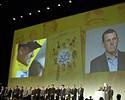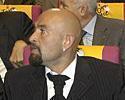
| Tour home |
| Preview |
| Photos |
| Live coverage |
| Start list |
| Stages & results |
| News |
| Map & profiles |
| Tour diaries |
| Features & tech |
| FAQ |
| Tour history |
Recently on Cyclingnews.com |
Tour de France - July 5-27, 2003
The route for the Centenary - "a traditional Tour", says Armstrong
By Cyclingnews staff
 |
The complete route of the 2003 Centenary Tour de France was announced on October 24 in Paris at the Palais des Congres. As was previously known, the route will (broadly speaking) follow the original 1903 Tour, which visited six cities: Paris, Lyon, Marseilles, Toulouse, Bordeaux, and Nantes. The 2003 Tour will also visit these cities, although there will certainly be more than six stages!
Reigning four-time TdF champion (1999, 2000, 2001 & 2002) Lance Armstrong explained to Cyclingnews that "I think this is a traditional Tour, actually. It's back to focusing the key mountain days in the middle. The biggest difference (next year) is that there are only three actual uphill finishes which doesn't suit us necessarily. I like the route though. It has an enormous amount of historical perspective while also being very modern."
The 2003 Tour starts on Saturday, July 5 at the Eiffel Tower in Paris with a prologue running along the banks of the Seine River, finishing at La Maison de la Radio. Stage 1 on Sunday, July 6, will see a neutral start at Stade de France, St Denis, travelling through the streets of Paris south to Montgeron's café Le Reveil Matin. That's where the 1903 Tour started at 3:16pm precisely, and the same start time will be used for Stage 1 of next year's race. The stage will finish in Meaux after 168 km.
 |
The Tour will then head east for two stages, visiting La Ferté sous Jouarre, Sedan, Charleville-Mézières and Saint-Dizier, which will see the finish of the Stage 4 team time trial (Joinville - Saint-Dizier, 68 km). Then it will head south towards Lyon, the second of the six historical cities, passing via Troyes and Nevers, the home of French cycle manufacturing companies Look and Time, with the sixth stage on July 11 finishing in Lyon.
This will be followed by three stages in the Alps. The first will start in Lyon and finish in Morzine, and although not overly difficult at 226.5 km it will be the longest stage of the Tour. The second will start at Sallanches and finish at Alpe d'Huez, passing via the harder side of the Col du Galibier and the Monument Henri Desgranges, a total of 211 km. The third Alpine stage will start from Bourg d'Oisans and finish in Gap, passing via the Col d'Izoard, where the two monuments to Fausto Coppi and Louison Bobet are located. Then the Tour will travel from Gap to Marseilles, the third ville etape, before a transfer to Narbonne for the first rest day on July 16.
 |
Stage 11 (July 17) will take place from Narbonne to Toulouse (the fourth historical city) over 160 km. This will be followed by the first individual time trial starting in Gaillac and finishing in the Cap'Découverte leisure centre, over 48.5 km. Then there will be four Pyrenean stages, the first (Stage 13) starting from Toulouse and finishing at Plateau de Bonascre (197.5 km); Stage 14 is from Aix-les Thermes to Loudenvielle (191.5 km; Stage 15 starts in Bagnères de Bigorre and finishes at Luz Ardiden, passing via the Tourmalet and the Jacques Goddet monument; and Stage 16, which comes after the second rest day in Pau, finishes at Bayonne. This stage includes five climbs, notably the steep Col du Soudet and is over 197.5 km.
The final few stages will see a stop in Bordeaux (fifth city) on Stage 17, before the Tour heads north to Saint Maixent l'Ecole for Stage 18. The final time trial will be from Pornic to Nantes, the sixth and final ville etape, and be run over 49 kilometres. The final stage will start from in Ville d'Avray, where the 1903 Tour finished, then head to the centre of Paris for the traditional Champs Elysées finish.
22 teams will take part in the 2003 Tour: 14 teams were automatically qualified by the end of 2002. Four wild cards were chosen at the beginning of 2003, based on ranking, and four more on May 15.
Cyclingnews has compiled many opinions of the 2003 route from riders and team management, as well as photos from the presentation, including a special picture of 21 of the 22 living TdF champions.
Participation in the Tour
22 teams of nine riders will be selected for the 2003 Tour de France. The selection will take place over three rounds in accordance with the new UCI rules for the three Grand Tours. 14 teams will automatically qualify in mid-November, 2002 based on the end of season UCI rankings. Then four wild cards will be select at the end of January 2003, after the registration of the new trade teams (e.g. Quick Step-Davitamon). Finally, four more wild cards will be chosen on May 15, which according to the organisers "will take into account the sporting results obtained by the potential teams."
Assuming no changes to the teams rankings based on the last UCI classification, and taking into account the teams that are stopping at the end of the season, the following 14 teams are automatically qualified for the 2003 Tour:
Fassa Bortolo
US Postal Service
Lotto-Adecco
Cofidis
Team Coast (now Team Bianchi)
ONCE-Eroski
iBanesto.com
Rabobank
Team CSC
Gerolsteiner
Team Telekom
Kelme-Costa Blanca
Alessio
Tacconi Sport (now Vini Caldirola-So.Di)
The remaining eight teams, selected in two wild card announcements, are:
Quick.Step-Davitamon
Saeco
Credit Agricole
FDJeux.com
Jean Delatour
Ag2R Prevoyance
Brioches la Boulangere
Euskaltel-Euskadi
|
